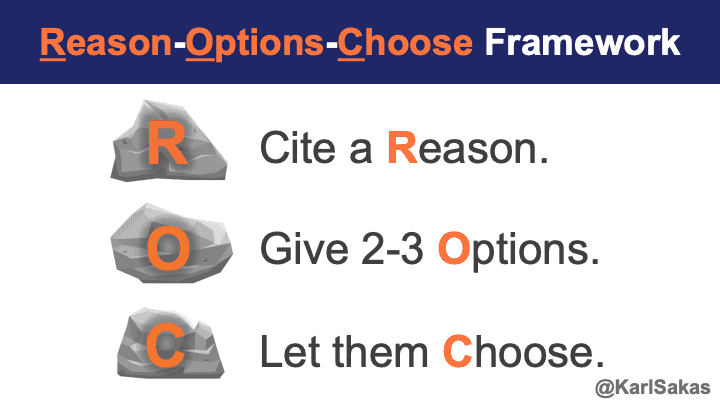Got lots of clients pushing you and your agency’s team to do things you don’t want to do? Use my “Reason-Options-Choose” (R-O-C) negotiation framework to say “no” to clients, without burning bridges.
It’s hard to say “no” to clients, especially when you know they want to hear “yes.” From my decades of client service experience in marketing, I’ve found it’s easier to say “no” to clients when you have a process.
I learned much of this the hard way—I’d love to make it easier for you and your team.
Three Steps to R-O-C
Reason-Options-Choose gives you—and your client-facing team—a way to diplomatically say “no” to clients and prospects. The key is that you’re giving people choices. There are three steps:
1. Cite a Reason why you can’t do what they want.
2. Give them 2-3 Options.
3. Let them Choose which they prefer.
R-O-C is consistently the #1 takeaway when I do audience surveys after my “Don’t Just Make the Logo Bigger” client service keynote. Let’s look at an example from my experience doing agency client service.
Example of Reason-Options-Choose
As an agency Director of Client Services, I had a particularly difficult client who always wanted to pay less. He loved getting deals—which included trying to get us to cut out prices, even after we’d already given him a fair quote. Here, I’ll adjust to 2025 dollars.
Some time ago, I quoted a particular project at $25,000—but he said he’d pay just $16,000. It seemed like we were stuck—so it was time for Reason-Options-Choose!
- In the followup meeting, I started by citing a Reason—”We evaluated your goals. Based on the scope, this is a $25,000 job.”
- I then offered at an alternative—”I worked with our team to see what we could accomplish for $16,000. Here’s a smaller-scope deliverable that would still meet your baseline goals.” Now, he had two Options.
- Finally, I let him Choose—”We can either build the full scope for $25,000 or the reduced scope to fit your $16,000 budget. Which do you prefer?”
In this particular example, he ultimately went with the $25,000 option—spending 50%+ more than his stated budget—because he wasn’t willing to cut any features from the scope.
But our agency would have won either way—we’d get paid appropriately for our work.
Ways to Use Reason-Options-Choose
You can use R-O-C in sales, in client service, and in project management. Here are some sample scenarios:
- Prospect wants you to start before they sign a contract.
- Client asks you to do something stupid.
- Prospect’s budget is too small.
- Client wants an out-of-scope change.
- They keep calling for help after launch.
- A software platform changed its API and something broke.
- Past-due client wants new, urgent work.
- Client wants extra-fast turnaround.
- They want you to guarantee the completion ETA before they sign.
- Client wants you to pay for a big-ticket item…but they’ll repay you later.
- Prospect wants a price quote on-the-spot.
Using R-O-C at Your Agency
During my client service talk, I do improv skits where audience members play difficult clients and I play the agency person using R-O-C. The skits are typically a cathartic experience, both for the volunteers and for the audience.
The R-O-C framework doesn’t work when a client is being totally unreasonable—but I find it works in most agency client service situations, if you value setting appropriate boundaries.
If you have difficult clients, I challenge you to use Reason-Options-Choose in the next week. You may not become best friends with that difficult client—but it’ll help to put you on equal professional footing.
Question: What will you change about how you say No to clients?



